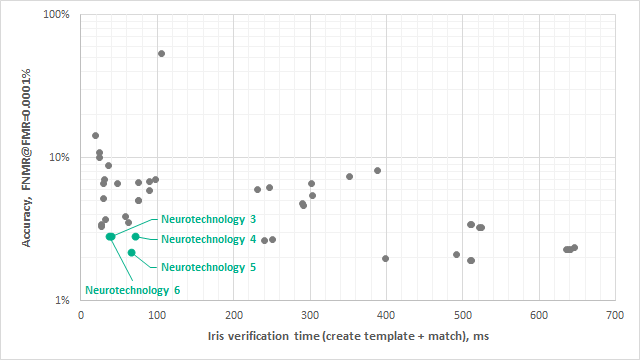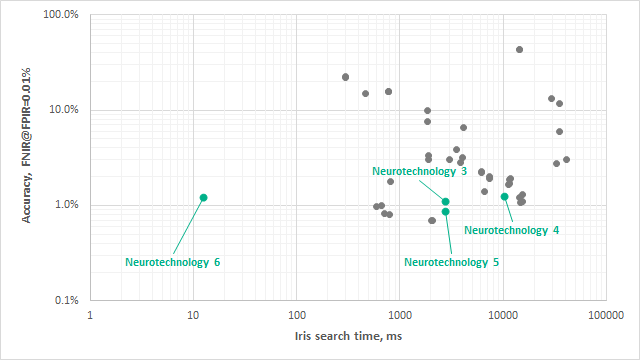IREX IX Evaluation
Neurotechnology's iris recognition algorithms have been judged by NIST as the second most accurate among the IREX IX participants. The accelerated version of the algorithms were nearly 50 times faster than any other matcher in the NIST IREX IX evaluation.
NIST Iris Exchange (IREX) IX is an evaluation of automated iris recognition algorithms. The National Institute of Standards and Technology (NIST) has evaluated 46 iris recognition algorithms from 13 commercial organizations and research institutions. The tests were run over operational data for both verification (one-to-one) and identification (one-to-many) tasks. The main goals of the evaluation were: to assess the current state of the art, facilitate research and development, and assess the impact of demographics. We will focus on the current state of the art in the following paragraphs.
The evaluation started in April 15, 2016 and continued through 3 submission phases until the final deadline for the third phase on September 1, 2017. During this time we have submitted two different generations of our iris recognition algorithms, namely 9.0 and 10.0. The final report from NIST overviews evaluation results for submissions from the second and third phases only. In our case, submissions from the second phase ("Neurotechnology 3" and "Neurotechnology 4") correspond to generation 9.0 and submissions from the third phase ("Neurotechnology 5" and "Neurotechnology 6") correspond to generation 10.0.
For verification task our final submissions are exactly the same iris recognition algorithms which have already been available to our clients since VeriEye 10.0 and MegaMatcher 10.0 SDKs:
- The submission "Neurotechnology 5" is our most accurate version which is accessible in our SDKs by default without changing any parameters.
- The submission "Neurotechnology 6" is the same algorithm, but optimized for extraction speed. It can be enabled by changing a single parameter in the SDK .

The submission "Neurotechnology 5" is the second most accurate among all tested iris verification algorithms. Multiple submissions, which show better accuracy than "Neurotechnology 5", were done by the one more accurate vendor, which provided 7 times slower iris image processing, created about 2.5 times larger templates and matched irises at 2 times lower speed than our submission.
Similarly, our final submissions for identification task are exactly the same iris recognition algorithms, which have been already available to our customers since the earlier release of VeriEye SDK and MegaMatcher SDK. In addition, we demonstrated the speed of our accelerated iris matching algorithm (submission "Neurotechnology 6"), which is integrated in the MegaMatcher Accelerator.

The submission "Neurotechnology 5" is again the second most accurate among all tested iris identification algorithms. Multiple submissions, which show better accuracy than "Neurotechnology 5", were done by single more accurate vendor. Even though the accelerated version of iris matching algorithm in the submission "Neurotechnology 6" was used together with a template extractor, which was optimized for extraction speed and provided slightly lower accuracy, the overall submission accuracy was degraded only by 35 % and remained among the most accurate algorithms. If the accelerated iris matching algorithm is combined with our most accurate iris extraction algorithm, the decrease in accuracy will be even less noticeable. According to the NIST report, our accelerated iris matcher was almost 50 times faster than any other iris matcher tested in the IREX IX evaluation.
See the IREX IX official page and full report for more information on the IREX program and testing methodology.
